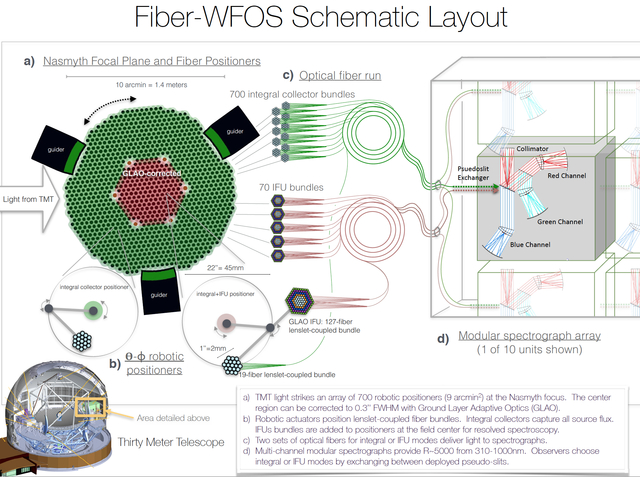WFOS Workshop
New Science with TMT's Wide-Field Optical Spectrograph (WFOS)
- Date: November 06 (half day, afternoon only)
- Location: Mysore, Infosys Campus (same as TMT Science Forum). Room: TBD
- Contact person: Kevin Bundy (kbundy@ucsc.edu)
- Workshop Goals: Recent progress in both distant and nearby galaxy studies, stellar surveys of the Milky Way and Andromeda, and growing excitement from time-domain discoveries are shaping how we think about the scientific potential of deep optical spectroscopy with TMT-WFOS. At the same time, WFOS is at a crossroads between a monolithic spectrograph design and a modular, fiber-based instrument, with a down-select anticipated in March 2018. The goal of this workshop is to highlight recent advances that are relevant to future WFOS programs and to foster discussion about new science opportunities enabled by the two designs under study.
- Program
- Background information:
-
-
Design Summary: We are studying two different WFOS instrument concepts and aiming to make a down-select in March 2018. The “Slicer-WFOS” concept is a monolithic slit-mask spectrograph (similar to Keck's DEIMOS or LRIS) that provides similar capabilities as the previous WFOS/MOBIE designs but in a different way that mitigates many of the challenges we faced before. The “Fiber-WFOS” concept introduces a radically different design that uses optical fibers to increase the number of simultaneous targets that could be observed to 700 (compared to 25-100) over a larger field of view. Fiber-WFOS would also provide resolved spectroscopy by deploying ~70 IFUs over a central area that could be corrected to 0.3’’ FWHM by ground-layer adaptive optics (GLAO).
-
What is WFOS for? WFOS is primarily a multi-object spectrograph optimized for the faintest sources, but it will also provide rapid followup of transient objects. It offers R~5000 spectral resolution from 310-1000nm (an R~1500 option with greater multiplex is an option for the monolithic concepts). The science case includes IGM tomography and high-z galaxy studies at z=2-5, stellar observations as probes of M31 and other local group galaxy assembly histories, resolved (GLAO-enabled) spectroscopy of galaxies at z~1, and transient followup.
-
Design options:
-
Fiber-WFOS: A fiber-based WFOS concept is new to TMT and is therefore a major part of our design work in this phase. The attached diagram shows the schematic layout. Roughly 700 robotic positioners would be mounted to a rotating focal plate at the TMT Nasmyth focus, spanning a 10 arcmin diameter field. Each actuator would position a fiber bundle (19-fibers each) on desired targets. Having multiple fibers in each bundle is a necessity given TMT’s fine plate scale (2.1mm per arcsec) but also offers advantages in optimal extraction of source flux. The roughly 10,000 fibers emerging from the backend would be injected into ~10 mounted spectrographs, each with 3 or 4 channels providing full wavelength coverage at R~5000.
In such a design, the cost of the fiber and associated bundles is a small fraction of the spectrograph and robotic positioner costs. This makes it possible to deploy multiple sets of fibers with different configurations at the focal plane at little extra cost.
In Fiber-WFOS, we would deploy a second set of fibers arranged in ~70 IFUs, each with 127 fibers and spanning 1-2’’ on the sky, but configured to spatially sample scales of 0.15’’, appropriate for resolved spectroscopy across GLAO’s 0.3’’ FWHM-corrected field.
-
Slicer-WFOS: The Slicer-WFOS concept provides capabilities more similar to the MOBIE-based designs, but instead of achieving R~5000 with a cross-dispersing prism, Slicer-WFOS would do so by utilizing narrower effective slits. This monolithic spectrograph would have a single VPH grating that would deliver R~1600 for 0.75’’ wide slits and R~5000 for 0.25’’ slits.
To gain back the slit aperture losses with 0.25’’ wide slits, one could deploy ~25 "slit slicers” across the field. Each would slice a 0.75’’ wide slit into three slitlets. Using a series of small mirrors, the upper and lower slitlets get re-imaged to either side of the central slit. From the point of view of the spectrograph, the flux incident on one 0.75’’ wide slit appears as three adjacent 0.25’’ slits, all of which could be combined later.
As with MOBIE, the observer could trade greater spectral resolution for lower multiplex. At R~1600, it would be possible to observe ~100 objects using a standard slit mask. At R~5000, ~25 objects could be observed in slicer modules positioned across the field.
-
-

